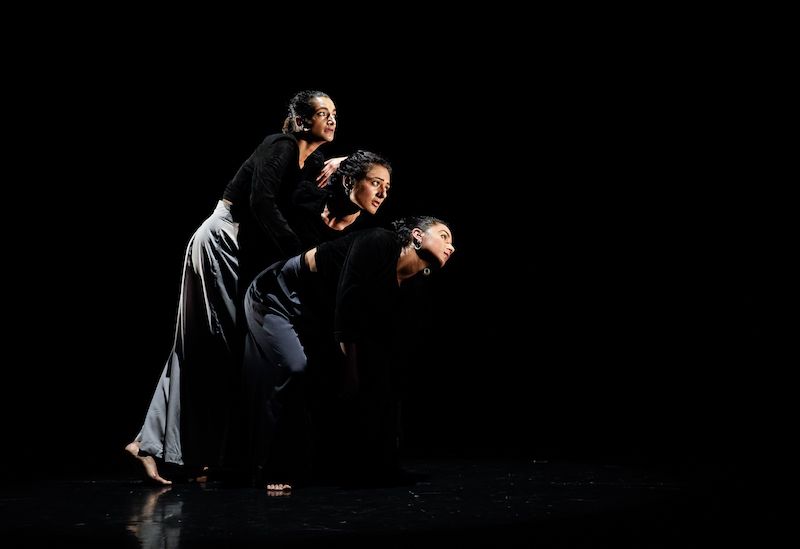Resolution! is an annual programme at The Place (home of London Contemporary Dance School), devoted to showcasing new choreographers. Over the past 30 years several have gone on to make it big, so there’s a reasonable chance that, somewhere among this year’s selection of 81 wannabes lurks a Wayne McGregor, a Hofesh Schechter or a Kate Prince waiting to be discovered.
Each gets 20 minutes of a triple bill and quality isn’t guaranteed (the pieces having been selected on the basis of a written outline six months in advance) but this year’s opening night managed two out of three, with Lynn Dichon’s solo Rose the standout (main picture). The choreographer's note told us that the piece was inspired by dissociative identity disorder, and I'm glad I didn't allow that to put me off. What transpired was a transfixing, virtuosic and often comic depiction of a woman’s inner turmoil as she assumed a succession of personalities, mostly at breathless speed.
Dressed for the office, Dichon began seated at a desk, moving invisible items fastidiously around it. To a soundtrack of Betty Boop, the secretary persona soon gave way to others, each more obsessive than the last, whether bouncing like a Spacehopper, crawling at the speed of a snail, or tangling arms with legs like an origami spider. So deft and entertaining was Dichon’s performance that I could have wished her piece had been longer.
 Shivaangee Agrawal's North (pictured above) picked a theme more common to Resolution seasons, contrasting a classical discipline with a contemporary dismantling of it. Agrawal’s training is in bharatanatyam, a south Indian dance form of taut rhythmic patterns. Her cast of three dancers, including herself, initially kept within a tight circle, stamping barefoot tattoos and gesturing in unison as they completed loop after mesmerising loop to a recording of spoken rhythmic syllables. This is the traditional means by which one bharatanatyam dancer dictates the steps to another. As lyrical cello took its place, one by one each dancer broke free, weaving a different path or upsetting the pulse with sudden, random handclaps. The piece had a satisfying logic, both spatial and emotional, that stayed with you.
Shivaangee Agrawal's North (pictured above) picked a theme more common to Resolution seasons, contrasting a classical discipline with a contemporary dismantling of it. Agrawal’s training is in bharatanatyam, a south Indian dance form of taut rhythmic patterns. Her cast of three dancers, including herself, initially kept within a tight circle, stamping barefoot tattoos and gesturing in unison as they completed loop after mesmerising loop to a recording of spoken rhythmic syllables. This is the traditional means by which one bharatanatyam dancer dictates the steps to another. As lyrical cello took its place, one by one each dancer broke free, weaving a different path or upsetting the pulse with sudden, random handclaps. The piece had a satisfying logic, both spatial and emotional, that stayed with you.
The following night’s Gallo Rojo Gallo Negro, by Juan Sanchez Plaza, had patchier success. Gallo is Spanish for “rooster”, and the piece used the farruca, traditionally a strutting man’s dance, as a base from which to question gender identity. But the farruca’s distinctive line and crisp footwork quickly petered out, leaving Irene Gimenez Montes in her black trousersuit idling in shadow while Sanchez Plaza, fully illuminated and wearing a swishy red skirt, seemed interested only in the undulations of his own naked torso. The gut-punch came in the short video closer in which, alone in a bedroom, staring at his shadow on a wall, he appeared to undergo some kind of psychological meltdown to the song “There Was a Boy”. In its way, this was quietly devastating.
Not all the submissions in the Resolution season take the form of a carefully rehearsed performance. Monika Blaszczak took a very different tack in How To Mimesis [sic]. Perhaps someone should point out the difference between a noun and a verb. Her idea, indeed her passion (as she told us in a rambling introduction) is that the artistic community needs to “practise being invisible” in order to counter an increasingly right-wing political culture. Blaszczak thus called for six volunteers to join her own six dancers in becoming “invisible” on stage. The responses were, if mildly amusing, far from sophisticated, and included such well-known invisibility tricks as crouching staring at the floor, and hiding under a coat. When Blaszczak added a new task – “Become highly visible!” – the result was remarkable mainly for the amount of shouting. As a conversation starter this piece could have worked, with snappier delivery and more development – much more.













Add comment